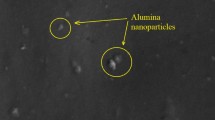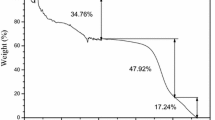Abstract
This study experimentally investigated the effects of acidic environments on the absorptive, morphological, mechanical, structural, and thermal properties of glass-carbon/epoxy-based hybrid composites. For this purpose, hybrid composite specimens were conditioned by immersion in an acidic environment with pH 1.0 at -10, 25, and 40 °C for different periods (1 day, 1–3-6–9-12 weeks). A comparative study was conducted to evaluate the properties of dry and acid-immersed specimens and to examine failures due to the acidic environment and temperature. It has been observed that all properties of hybrid composites are significantly affected by acidic environmental conditions, and failure development is highly dependent on acidic ambient temperature and exposure time.














Similar content being viewed by others
References
Gibson RF (2016) Principles of composite material mechanics. Boca Raton, Florida, United States
Reddy JN (2003) Mechanics of laminated composite plates and shells. Boca Raton, Florida, United States
Kaw AK (2005) Mechanics of composite materials, 2nd edn. CRC Press
Nurazzi NM, Asyraf MRM, Fatimah Athiyah S et al (2021) A review on mechanical performance of hybrid natural fiber polymer composites for structural applications. Polymers (Basel) 13(13):2170
Nguyen H, Zatar W, Mutsuyoshi H (2017) Hybrid polymer composites for structural applications. Hybrid polymer composite materials: applications. Woodhead Publications, Cambridge, UK
Swolfs Y, Gorbatikh L, Verpoest I (2014) Fibre hybridisation in polymer composites: A review. Compos Part A Appl Sci Manuf 67:181–200
Hayashi T (1972) On the improvement of mechanical properties of composites by hybrid composition. 8th international reinforced plastics conference. British Plastic Federation, Brighton
Bunsell AR, Harris B (1974) Hybrid carbon and glass fibre composites. Composites 5:157–164. https://doi.org/10.1016/0010-4361(74)90107-4
Manders PW, Bader MG (1981) The strength of hybrid glass/carbon fibre composites - Part 1 Failure strain enhancement and failure mode. J Mater Sci 16:2233–2245. https://doi.org/10.1007/BF00542386
Pimenta S, Pinho ST (2013) Hierarchical scaling law for the strength of composite fibre bundles. J Mech Phys Solids 61:1337–1356. https://doi.org/10.1016/j.jmps.2013.02.004
Swolfs Y, Gorbatikh L, Verpoest I (2013) Stress concentrations in hybrid unidirectional fibre-reinforced composites with random fibre packings. Compos Sci Technol 85:10–16. https://doi.org/10.1016/j.compscitech.2013.05.013
Swolfs Y, Gorbatikh L, Romanov V et al (2013) Stress concentrations in an impregnated fibre bundle with random fibre packing. Compos Sci Technol 74:113–120. https://doi.org/10.1016/j.compscitech.2012.10.013
Xing J, Hsiao GC, Chou TW (1981) A dynamic explanation of the hybrid effect. J Compos Mater 15:443–461. https://doi.org/10.1177/002199838101500504
Ravishankar B, Nayak SK, Kader MA (2019) Hybrid composites for automotive applications – A review. J Reinf Plast Compos 38:835–845. https://doi.org/10.1177/0731684419849708
Chauhan A, Kumar M, Kumar S (2021) Fabrication of polymer hybrid composites for automobile leaf spring application. Mater Today Proc 48(5):1371–1377
Kolpachkov ED, Kurnosov AO, Petrova AP, Raskutin AE (2020) Fiber-based hybrid polymer composites for aviation: a review. Vopr Materialoved 1:126–138. https://doi.org/10.22349/1994-6716-2020-101-1-126-138
Raj K, Vasudevan A, Pugazhendhi L (2021) A review on different hybrid composites for aircraft structures. Mater Today Proc. https://doi.org/10.1016/j.matpr.2020.10.774
Gururaja MN, Rao ANH (2012) A review on recent applications and future prospectus of hybrid composites. Int J Soft Comput Eng 1(6):352–355
Jagadeesh P, Puttegowda M, Girijappa YGT et al (2022) Carbon fiber reinforced areca/sisal hybrid composites for railway interior applications: mechanical and morphological properties. Polym Compos 43:160–172. https://doi.org/10.1002/pc.26364
Dinesh S, Elanchezhian C, Vijayaramnath B et al (2020) Experimental investigation of natural and synthetic hybrid composite for marine application. Mater Today Proc 22(3):322–329
Fiore V, Di Bella G, Valenza A (2011) Glass-basalt/epoxy hybrid composites for marine applications. Mater Des 32:2091–2099. https://doi.org/10.1016/j.matdes.2010.11.043
Swolfs Y (2017) Perspective for fibre-hybrid composites in wind energy applications. Materials (Basel) 10(11):1–17
Reddy SSP, Suresh R, Hanamantraygouda MB, Shivakumar BP (2021) Use of composite materials and hybrid composites in wind turbine blades. Mater Today Proc 46(7):2827–2830
Zhang J, Chaisombat K, He S, Wang CH (2012) Glass/carbon fibre hybrid composite laminates for structural applications in automotive vehicles. Sustainable automotive technologies. Springer, Berlin, Heidelberg
Bhagwat PM, Ramachandran M, Raichurkar P (2017) Mechanical properties of hybrid glass/carbon fiber reinforced epoxy composites. Mater Today Proc 4:7375–7380
Jesthi DK, Nayak RK (2019) Improvement of mechanical properties of hybrid composites through interply rearrangement of glass and carbon woven fabrics for marine application. Compos Part B Eng 168:467–475. https://doi.org/10.1016/j.compositesb.2019.03.042
Summerscales J (2019) Materials selection for marine composites. Marine composites. Elsevier Ltd, Amsterdam, Holland
Wahrhaftig A, Ribeiro H, Nogueira A (2019) A structural composite for marine boat constructions. Marine composites. Woodhead Publishing, Cambridge, UK
Metyx composites (2017) The world’s largest carbon hybrid composite catamaran. https://www.metyx.com/wp-content/uploads/PDF_Files/Marin_Brochure.pdf. Accessed 15 Jan 2024
Summerscales J, Short D (1978) Carbon fibre and glass fibre hybrid reinforced plastics. Composites 9:157–166. https://doi.org/10.1016/0010-4361(78)90341-5
Chandra DS, Reddy KVK, Hebbal O (2018) Fabrication and mechanical characterisation of glass and carbon fibre reinforced composite’s used for marine applications. Int J Eng Technol 7:228–232. https://doi.org/10.14419/ijet.v7i4.5.20052
Mishnaevsky L, Branner K, Petersen HN et al (2017) Materials for wind turbine blades: an overview. Materials (Basel) 10(11):1–24
Mishnaevsky L, Dai G (2014) Hybrid carbon/glass fiber composites: micromechanical analysis of structure-damage resistance relationships. Comput Mater Sci 81:630–640. https://doi.org/10.1016/j.commatsci.2013.08.024
Raji M, Zari N, Bouhfid R, El Kacem Qaiss A (2018) Durability of composite materials during hydrothermal and environmental aging. Durability and life prediction in biocomposites, fibre-reinforced composites and hybrid composites. Woodhead Publishing, Cambridge, UK
Burns DA, Aherne J, Gay DA, Lehmann CMB (2016) Acid rain and its environmental effects: Recent scientific advances. Atmos Environ 146:1–4
Sanliyuksel Yucel D, Balci N, Baba A (2016) Generation of acid mine lakes associated with abandoned coal mines in Northwest Turkey. Arch Environ Contam Toxicol 70:757. https://doi.org/10.1007/s00244-016-0270-z
Löhr AJ, Bogaard TA, Heikens A et al (2005) Natural pollution caused by the extremely acidic crater lake Kawah Ijen, East Java. Indonesia Environ Sci Pollut Res 12:89–95
Qiu Q, Kumosa M (1997) Corrosion of E-glass fibers in acidic environments. Compos Sci Technol 57:497–507. https://doi.org/10.1016/S0266-3538(96)00158-3
Xue Y, Veazie DR, Glinsey C et al (2007) Environmental effects on the mechanical and thermomechanical properties of aspen fiber-polypropylene composites. Compos Part B Eng 38:152–158. https://doi.org/10.1016/j.compositesb.2006.07.005
Buck SE, Lischer DW, Nemat-Nasser S (2001) Mechanical and microstructural properties of notched E-glass/vinyl ester composite materials subjected to the environment and a sustained load. Mater Sci Eng A 317:128–134. https://doi.org/10.1016/S0921-5093(01)01170-4
John K, Naidu SV (2007) Chemical resistance of sisal/glass reinforced unsaturated polyester hybrid composites. J Reinf Plast Compos 26:373–376. https://doi.org/10.1177/0731684406072524
Singh P, Kaushik A, Kaur K (2005) Mechanical properties and swelling behavior of short glass fiber reinforced polyester composites. J Thermoplast Compos Mater 18:543–559. https://doi.org/10.1177/0892705705055444
Amaro AM, Reis PNB, Neto MA, Louro C (2013) Effects of alkaline and acid solutions on glass/epoxy composites. Polym Degrad Stab 98:853–862. https://doi.org/10.1016/j.polymdegradstab.2012.12.029
Pai R, Kamath MS, Rao RMVGK (1997) Acid resistance of glass fibre composites with different lay-up sequencing part II: degradation studies. J Reinf Plast Compos 16:1013–1019. https://doi.org/10.1177/073168449701601103
Pai R, Kamath MS, Rao RMVGK (1997) Acid resistance of glass fibre composites with different lay-up sequencing: Part I-diffusion studies. J Reinf Plast Compos 16:1002–1012. https://doi.org/10.1177/073168449701601102
Mahmoud MK, Tantawi SH (2003) Effect of strong acids on mechanical properties of glass/polyester GRP pipe at normal and high temperatures. Polym Plast Technol Eng 42:677–688. https://doi.org/10.1081/PPT-120023102
Huntsman (2020) Advanced materials. https://www.huntsman.com/docs/Documents/20p_Resin_144699_Huntsman_Composites.pdf. Accessed 15 Jan 2024
Li Y, Wang Y, Wang Y, Wang B (2019) Effects of simulated acid rain on soil respiration and its component in a mixed coniferous-broadleaved forest of the three gorges reservoir area in Southwest China. For Ecosyst 6:32. https://doi.org/10.1186/s40663-019-0192-0
Weitsman YJ (2000) Effects of fluids on polymeric composites—a review. Compr Compos Mater 2:369–401
Barjasteh E, Nutt SR (2012) Moisture absorption of unidirectional hybrid composites. Compos Part A Appl Sci Manuf 43:158–164. https://doi.org/10.1016/j.compositesa.2011.10.003
Martin R (2008) Ageing of composites. Woodhead Publishing, Cambridge, UK
Chauhan A, Bedi HS, Agnihotri PK (2022) Enhancing aging resistance of glass fiber/epoxy composites using carbon nanotubes. Mater Chem Phys 291:126740. https://doi.org/10.1016/j.matchemphys.2022.126740
Osei Bonsu A, Liang W, Mensah C, Yang B (2022) Assessing the mechanical behavior of glass and basalt reinforced vinyl ester composite under artificial seawater environment. Structures 38:961–978. https://doi.org/10.1016/j.istruc.2022.02.053
Li H, Zhang K, Fan X et al (2019) Effect of seawater ageing with different temperatures and concentrations on static/dynamic mechanical properties of carbon fiber reinforced polymer composites. Compos Part B Eng 173:106910. https://doi.org/10.1016/j.compositesb.2019.106910
Schultheisz CR, Waas AM (1996) Compressive failure of composites, Part I: Testing and micromechanical theories. Prog Aerosp Sci 32(1):1–42
Opelt CV, Cândido GM, Rezende MC (2018) Compressive failure of fiber reinforced polymer composites – A fractographic study of the compression failure modes. Mater Today Commun 15:218–227. https://doi.org/10.1016/j.mtcomm.2018.03.012
Budiansky B, Fleck NA (1993) Compressive failure of fibre composites. J Mech Phys Solids 41:183–211. https://doi.org/10.1016/0022-5096(93)90068-Q
Bonsu AO, Mensah C, Liang W et al (2022) Mechanical degradation and failure analysis of different glass/basalt hybrid composite configuration in simulated marine condition. Polymers (Basel) 14:3480. https://doi.org/10.3390/polym14173480
Dong C, Ranaweera-Jayawardena HA, Davies IJ (2012) Flexural properties of hybrid composites reinforced by S-2 glass and T700S carbon fibres. Compos Part B Eng 43:573–581. https://doi.org/10.1016/j.compositesb.2011.09.001
Hulugappa B, Achutha MV, Suresha B (2016) Effect of environmental conditions on flexural strength and fracture toughness of particulate filled glass-epoxy hybrid composites. Mater Sci Appl 7:710–729. https://doi.org/10.4236/msa.2016.711057
Bonon AJ, Weck M, Bonfante EA, Coelho PG (2016) Physicochemical characterisation of three fiber-reinforced epoxide-based composites for dental applications. Mater Sci Eng C 69:905–913. https://doi.org/10.1016/j.msec.2016.07.002
González MG, Cabanelas JC, Baselga J (2012) Applications of FTIR on epoxy resins - identification, monitoring the curing process, phase separation and water uptake. Infrared spectroscopy - materials science, engineering and technology. IntechOpen Ltd., London, UK
Örtengren U, Wellendorf H, Karlsson S, Ruyter IE (2001) Water sorption and solubility of dental composites and identification of monomers released in an aqueous environment. J Oral Rehabil 28:1106–1115. https://doi.org/10.1046/j.1365-2842.2001.00802.x
Maxwell a. S, Broughton WR, Dean G, Sims GD, (2005) Review of accelerated ageing methods and lifetime prediction technique for polymeric materials. Crown, Middlesex, UK
Amini M, Khavandi A (2019) Synergistic effects of mechanical and environmental loading in stress corrosion cracking of glass/polymer composites. J Compos Mater 53:3433–3444. https://doi.org/10.1177/0021998319842376
Uthaman A, Xian G, Thomas S et al (2020) Durability of an epoxy resin and its carbon fiber-reinforced polymer composite upon immersion in water, acidic, and alkaline solutions. Polymers (Basel) 12:614. https://doi.org/10.3390/polym12030614
Akderya T, Özmen U, Baba BO (2020) Investigation of long-term ageing effect on the thermal properties of chicken feather fibre/poly(lactic acid) biocomposites. J Polym Res 27:162. https://doi.org/10.1007/s10965-020-02132-2
Akderya T, Özmen U, Baba BO (2021) Revealing the long-term ageing effect on the mechanical properties of chicken feather fibre/poly(lactic acid) biocomposites. Fibers Polym 22:2602–2611. https://doi.org/10.1007/s12221-021-0304-7
Acknowledgements
The authors would like to acknowledge the support of The Scientific and Technological Research Council of Türkiye (TÜBİTAK) under Grant no. 120M158. All authors are truly grateful for the support.
Funding
The Scientific and Technological Research Council of Türkiye (TÜBİTAK),120M158,Buket Okutan Baba
Author information
Authors and Affiliations
Corresponding author
Ethics declarations
Conflict of interest
The authors declare that they have no known competing financial interests or personal relationships that could have appeared to influence the work reported in this paper.
Additional information
Publisher's Note
Springer Nature remains neutral with regard to jurisdictional claims in published maps and institutional affiliations.
Supplementary Information
Below is the link to the electronic supplementary material.
Rights and permissions
Springer Nature or its licensor (e.g. a society or other partner) holds exclusive rights to this article under a publishing agreement with the author(s) or other rightsholder(s); author self-archiving of the accepted manuscript version of this article is solely governed by the terms of such publishing agreement and applicable law.
About this article
Cite this article
Akderya, T., Horzum, N. & Baba, B.O. Effect of acidic environment on absorptive, morphological, mechanical, structural, and thermal properties of glass-carbon/epoxy-based hybrid composites. J Polym Res 31, 27 (2024). https://doi.org/10.1007/s10965-023-03860-x
Received:
Accepted:
Published:
DOI: https://doi.org/10.1007/s10965-023-03860-x




